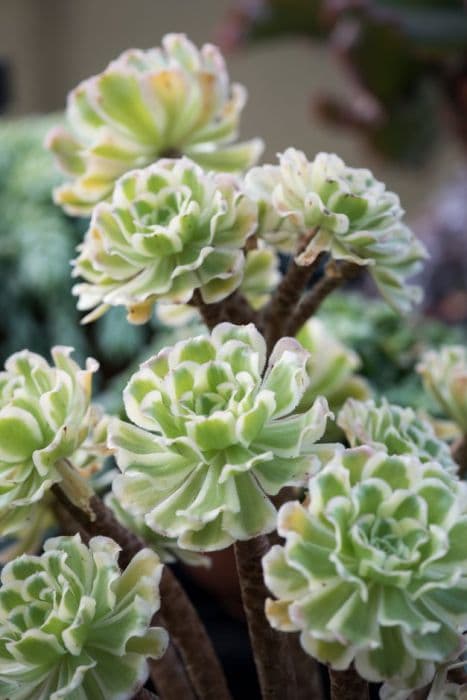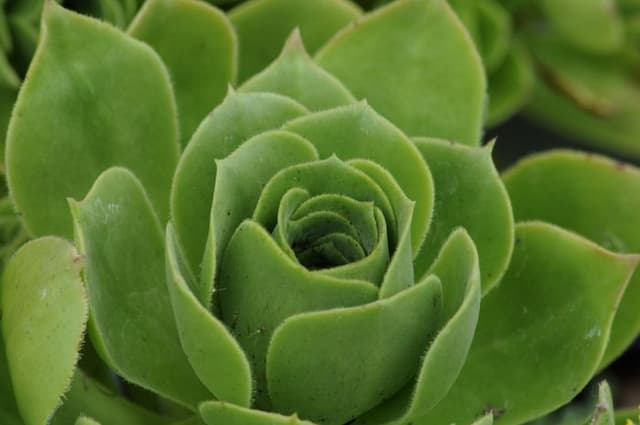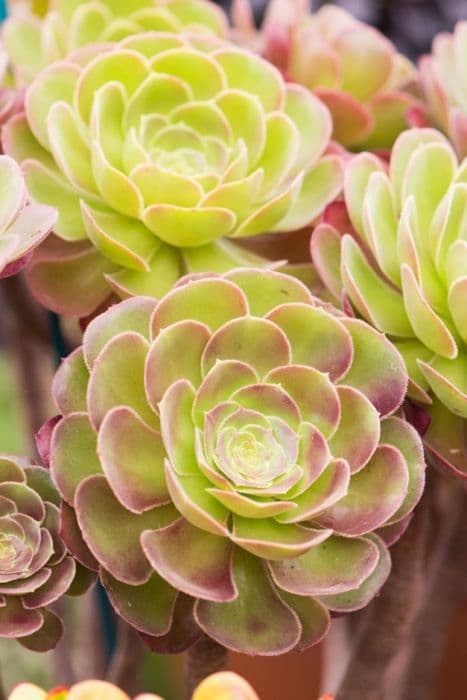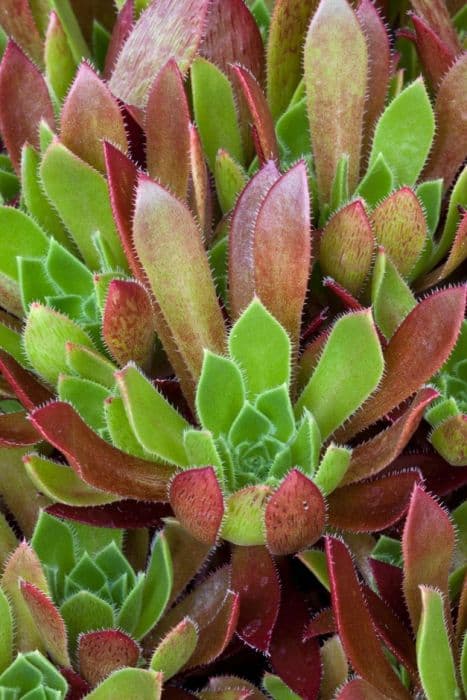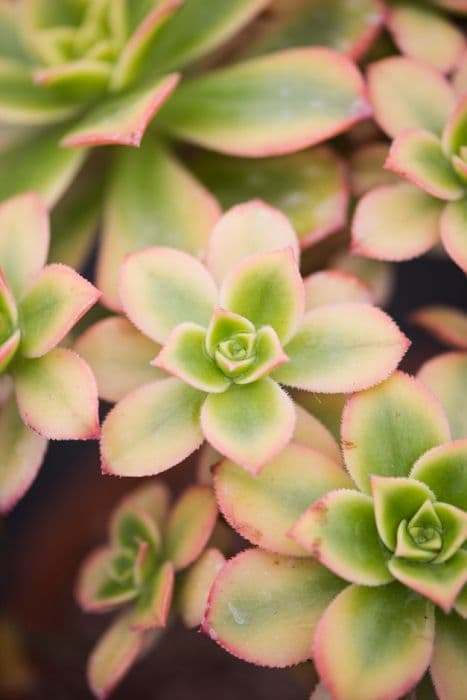Frosty Morn Stonecrop Hylotelephium erythrostictum 'Frosty Morn' (v)

ABOUT
'Frosty Morn' is an ornamental plant known for its striking foliage and blossoms. Its leaves showcase a variegated pattern with a predominant creamy white edge surrounding a green center, creating a strong visual contrast. The leaves are typically flat surfaced and grow in a clustered formation, providing a lush appearance. During the blooming period, clusters of small, starry flowers emerge, which are typically pinkish in color. These flowers tend to form dense clusters atop the stems, adding to the plant's decorative appeal. The overall impression of 'Frosty Morn' is that of a robust, bushy plant with a captivating mix of foliage colors complemented by appealing blooms.
About this plant
 Names
NamesFamily
Crassulaceae.
Synonyms
Frosty Morn Stonecrop, Variegated Stonecrop, Sedum 'Frosty Morn'.
Common names
Sedum erythrostictum 'Frosty Morn'.
 Toxicity
ToxicityTo humans
The plant commonly known as Stonecrop is generally considered non-toxic to humans. However, consuming any part of the plant is not advisable. If ingested in large quantities, it may cause mild discomfort in the gastrointestinal tract, such as nausea or diarrhea.
To pets
Stonecrop is also considered non-toxic to pets. It should not cause serious harm if pets ingest small amounts. However, as with humans, consumption of larger quantities might lead to gastrointestinal discomfort or upset, potentially including vomiting or diarrhea in more sensitive animals. Always monitor your pets and prevent them from eating plants, as individual reactions can vary.
 Characteristics
CharacteristicsLife cycle
Perennials
Foliage type
Deciduous
Color of leaves
Variegated
Flower color
Pink
Height
1-2 feet (30-60 cm)
Spread
1-2 feet (30-60 cm)
Plant type
Herb
Hardiness zones
3-9
Native area
Asia
Benefits
 General Benefits
General Benefits- Attracts Pollinators: Hylotelephium erythrostictum 'Frosty Morn' provides nectar and pollen for bees and other pollinating insects.
- Drought Tolerance: This succulent is highly drought-resistant, making it suitable for xeriscaping and low-water gardens.
- Easy Care: Sedum 'Frosty Morn' is known for its low maintenance needs, requiring minimal attention once established.
- Seasonal Interest: With its attractive foliage and bright flowers, it adds aesthetic appeal to gardens across multiple seasons.
- Cold Hardy: It can withstand cold temperatures, making it a hardy choice for gardens in cooler climates.
- Soil Adaptability: This plant can thrive in a wide range of soil types, as long as there is good drainage.
- Pest Resistant: Sedum 'Frosty Morn' tends to be resistant to pests and diseases, reducing the need for chemical treatments.
- Ground Cover: It can serve as an effective ground cover, reducing weed growth and soil erosion.
- Architectural: Its distinctive form adds architectural interest to garden designs and landscapes.
- Edging: The compact growth habit of Sedum 'Frosty Morn' makes it a good choice for edging paths and borders.
 Medical Properties
Medical PropertiesThis plant is not used for medical purposes.
 Air-purifying Qualities
Air-purifying QualitiesThis plant is not specifically known for air purifying qualities.
 Other Uses
Other Uses- Frosty Stonecrop can serve as a natural mulch; its dense foliage and mat-forming habit suppress weeds effectively, reducing the need for additional mulching materials.
- As a soil erosion control measure; Frosty Stonecrop's root system helps stabilize soil on slopes or in areas prone to erosion.
- Assisting in butterfly gardens; because Frosty Stonecrop attracts butterflies which contributes to their conservation and supports biodiversity.
- When grown in containers, Frosty Stonecrop adds structure and interest to balcony gardens or urban settings where ground planting isn't possible.
- Used as a living roof plant; its drought tolerance and low-maintenance nature make it suitable for green roofing projects.
- Frosty Stonecrop can be cultivated as ground cover between stepping stones, softening the hardscape and providing a decorative element.
- In landscape design as a textural contrast; its succulent leaves and mounding habit contrast well with grasses and more delicate foliage.
- For winter gardens; Frosty Stonecrop provides interest in the colder months with its persistent, sometimes colorful, foliage after many plants have died back.
- As an educational tool in schools to teach students about xeriscaping and water conservation methods in gardening.
- In artistic installations, live Frosty Stonecrop may be utilized to create patterns or designs in eco-art projects.
Interesting Facts
 Feng Shui
Feng ShuiThe Sedum 'Frosty Morn' is not used in Feng Shui practice.
 Zodiac Sign Compitability
Zodiac Sign CompitabilityThe Sedum 'Frosty Morn' is not used in astrology practice.
 Plant Symbolism
Plant Symbolism- Resilience - Hylotelephium erythrostictum 'Frosty Morn', commonly known as Stonecrop, is known for its hardy nature and ability to withstand harsh conditions, symbolizing the ability to persevere and thrive despite challenges.
- Survival - Stonecrop can often survive in poor soil and drought-like conditions, representing survival and the tenacity of life.
- Tranquillity - With its succulent leaves and calm greenery, Stonecrop is often associated with tranquility and peace, providing a sense of calm and serenity to any garden space.
- Longevity - The plant’s ability to live for many years and easily propagate symbolizes longevity and enduring presence.
 Water
WaterFor the 'Frosty Morn' Stonecrop, water thoroughly but infrequently, allowing the soil to dry out between waterings to mimic its natural arid habitat. It's typically sufficient to water approximately once every 1-2 weeks during the growing season. Reduce watering to once a month or less during the dormant winter period. When you water, use enough to soak the soil around the roots — for a potted plant, this might be about one gallon depending on the pot size and soil composition.
 Light
LightThe 'Frosty Morn' Stonecrop thrives best in full sun to partial shade conditions. Ideally, locate the plant where it receives at least six hours of sunlight daily. Avoid deep shade as this can lead to leggy growth and reduced flowering. Morning sun with afternoon shade or dappled light throughout the day is optimal in hotter regions to prevent scorching.
 Temperature
TemperatureThe 'Frosty Morn' Stonecrop prefers temperatures between 60°F and 70°F for optimal growth but can tolerate a range from just above freezing to around 90°F. It is a hardy plant that can survive brief periods below freezing, but prolonged exposure to temperatures below 30°F may be harmful. Ensure winter protection if temperatures are expected to drop significantly below freezing.
 Pruning
PruningPrune 'Frosty Morn' Stonecrop to maintain shape, remove spent blooms, and promote denser growth. It's best to prune in late winter or early spring before new growth begins. Deadhead flowers after blooming to encourage a second flush of blooms. It may also be necessary to cut back the plant every few years to rejuvenate and prevent it from becoming too leggy.
 Cleaning
CleaningAs needed
 Soil
SoilSedum 'Frosty Morn' thrives best in a well-draining soil mix, with an ideal pH ranging between 6.0 and 7.5. A good recipe for soil mix is one part potting soil, one part perlite or coarse sand, and one part peat or compost to ensure drainage and fertility.
 Repotting
RepottingSedum 'Frosty Morn' typically needs repotting every 2 to 3 years to refresh the soil and accommodate root growth. Repot in spring when signs of crowding occur or if the plant starts to wilt.
 Humidity & Misting
Humidity & MistingSedum 'Frosty Morn' prefers low to moderate humidity levels and is quite tolerant of dry air conditions typical of most indoor environments.
 Suitable locations
Suitable locationsIndoor
Place in bright light, avoid overwatering, ensures drainage.
Outdoor
Full sun to partial shade, well-drained soil, tolerant of drought.
Hardiness zone
3-9 USDA
 Life cycle
Life cycleHylotelephium erythrostictum 'Frosty Morn', commonly known as Frosty Morn Stonecrop, starts its life as a seed that germinates in spring when soil temperatures warm. Emerging seedlings grow into fleshy, succulent stems with variegated leaves; during this juvenile phase, they establish a root system and foliage. As the plant matures, it enters a vegetative stage where it continues to grow and spread, often through rhizomes or by stem cuttings that root easily. In late summer to early fall, the adult Frosty Morn Stonecrop produces clusters of small, star-shaped flowers, attracting pollinators and setting the stage for seed production. After flowering, seeds are produced and dispersed, either by wind or wildlife, which then completes the reproductive cycle. In winter, the plant becomes dormant, with above-ground parts dying back, while the roots survive to sprout new growth the following spring.
 Propogation
PropogationPropogation time
Late Spring-Early Summer
The most popular method of propagation for the 'Frosty Morn' Stonecrop is by stem cuttings. This can be done in spring or early summer when the plant is actively growing. To propagate, select a healthy, non-flowering stem and cut a 3 to 4-inch (approximately 7.5 to 10 centimeters) portion just below a node. Remove the lower leaves to expose a short length of stem. Allow the cutting to callous for several days to prevent rotting, then plant it in a well-draining soil mix. Water sparingly until roots have formed and new growth appears, which indicates successful propagation.
